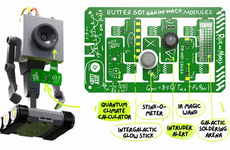
'Misbehaving (ro)bots' is a Series of Bothersome Bots
References: nicole-perez & dezeen
Nicole Perez's 'Misbehaving (ro)bots' aren't like the typical robotic helpers that one hears about or even makes use of in their daily lives. While most robots or AI helpers are designed to be as efficient and friction-free as possible, the Misbehaving (ro)bots project asks what it would be like if automated technology was a little more unruly. The robots in the project are designed to intentionally mimic annoying human characteristics like pinching and pulling at clothing, poking, and smearing lipstick on pillows.
Perez's project is cheeky, but its based in a crucial concept. As people learn to rely more and more on pristine robots and automated technology in general, those seamless systems will inevitably alienate us from the messy, clunky, and annoying reality of relationships. Misbehaving (ro)bots asks whether robots can even master the imperfections of human socialization.
Perez's project is cheeky, but its based in a crucial concept. As people learn to rely more and more on pristine robots and automated technology in general, those seamless systems will inevitably alienate us from the messy, clunky, and annoying reality of relationships. Misbehaving (ro)bots asks whether robots can even master the imperfections of human socialization.
Trend Themes
1. Annoying Robot Design - Companies can develop intentionally annoying robots as a new product category that pushes the boundaries of what is possible in robotic design.
2. Emulating Human Annoyances - Developers can create robots that mimic human annoyances for improved socialization, customer service, or therapy for people with sensory processing disorders.
3. Exploring Robot-human Relationships - Researchers can investigate how annoying robots can serve as a tool for increasing empathy between humans and machines, leading to more productive and meaningful interactions.
Industry Implications
1. Consumer Robotics - Companies in the consumer robotics industry can explore the potential for intentionally annoying robots to expand their product offerings and appeal to a wider market of customers.
2. Customer Service - Customer service industries can use intentionally annoying robots in their training programs as an effective tool to teach employees how to handle difficult or frustrating scenarios with customers.
3. Therapeutic Robotics - The field of therapeutic robotics can benefit from the development of irritating robots to help individuals with sensory processing disorders learn to cope with different emotional responses and improve their overall wellness.
6
Score
Popularity
Activity
Freshness
























